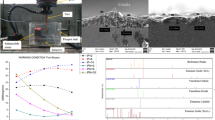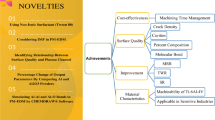Abstract
Electrical discharge machining (EDM) is known as one of the well-defined advanced manufacturing techniques. The electro-thermal property of EDM enables us to capture the electrical and thermal changes within the plasma channel. Our research has studied the impact of the electro-thermal of the plasma channel on surface integrity. We have analyzed the changes in the plasma channel by considering its physical characteristics based on the EDM’s input parameters such as discharge current (I), pulse-on time (Ton), and concentration of added Al powder (Cp). In our experiment, adding Al powder decreased the dielectric resistance of kerosene. Furthermore, our mathematical and physical model demonstrated that adding powder had a positive effect up to 2.5 g/l. Moreover, the uneven distribution of powders into dielectric caused unstable discharge on the surface. We also studied the defects and changes of the plasma channel’s features by using field emission scanning electron microscopy (FE-SEM). The consequence of the plasma channel changes led to the crack’s disappearance entirely when the Al powder was used. It should be noted that with Ti-6Al-4V, it is hard to machine material, which is usually due to low thermal conductivity and its volume-specific heat. In our study, the fast-cooling rate created a diffusionless acicular martensitic microstructure, which led to a distorted hexagonal close-packed (HCP) crystal structure with the designation α′. This occurred while a high rate of quenching martensitic α′ was formed. The plasma channel creates a recast layer, which was affected by metallurgical changes within the EDM process. By using electron dispersive scanning (EDS) method and elemental mapping, we observed that the cross-section of the workpiece in the HAZ area led to the optimized oxidization, carbonization, and degree of fragility on the surface. Moreover, as the rate of the current intensity increased from 15 to 20-25A, the machining time improved by 16%, 12%, and 7%, respectively. Our experiment is consistent with our proposed mathematical model, and it can have practical applications, especially in medical, aerospace, and automobile industries. To the best of knowledge, our mathematical model that we have proposed for our experiment detects appearance and disappearance of metallurgical defects.

















Similar content being viewed by others
References
Abu Qudeiri JE, Mourad A-HI, Ziout A, Abidi MH, Elkaseer A (2018) Electric discharge machining of titanium and its alloys: review. Int J Adv Manuf Technol 96:1319–1339. https://doi.org/10.1007/s00170-018-1574-0
Pramanik A (2014) Problems and solutions in machining of titanium alloys. Int J Adv Manuf Technol 70:919–928. https://doi.org/10.1007/s00170-013-5326-x
Kumar S, Singh R, Batish A, Singh TP (2012) Electric discharge machining of titanium and its alloys: a review. Int J Mach Mach Mater 11:84. https://doi.org/10.1504/IJMMM.2012.044922
Mahdavinejad RA, Ilani MA (2019) IJSRMME19339 | Superior advance research in the electro-discharge machining of Ti alloys: review. Int J Sci Res Mech Mater Eng 3:19–38
Prakash C, Kansal HK, Pabla B, Puri S, Aggarwal A (2016) Electric discharge machining–a potential choice for surface modification of metallic implants for orthopedic applications: a review. Proc Inst Mech Eng B J Eng Manuf 230:331–353. https://doi.org/10.1177/0954405415579113
Shabgard M, Khosrozadeh B (2017) Investigation of carbon nanotube added dielectric on the surface characteristics and machining performance of Ti–6Al–4V alloy in EDM process. J Manuf Process 25:212–219. https://doi.org/10.1016/j.jmapro.2016.11.016
Mirjavadi SS, Alipour M, Hamouda AMS, Matin A, Kord S, Afshari BM, Koppad PG (2017) Effect of multi-pass friction stir processing on the microstructure, mechanical and wear properties of AA5083/ZrO2 nanocomposites. J Alloys Compd 726:1262–1273. https://doi.org/10.1016/j.jallcom.2017.08.084
Nguyen TD, Nguyen PH, Banh LT (2019) Die steel surface layer quality improvement in titanium μ-powder mixed die sinking electrical discharge machining. Int J Adv Manuf Technol 100:2637–2651. https://doi.org/10.1007/s00170-018-2887-8
Mohanty A, Talla G, Gangopadhyay S (2014) Experimental investigation and analysis of EDM characteristics of Inconel 825. Mater Manuf Process 29:540–549. https://doi.org/10.1080/10426914.2014.901536
Chen S-L, Lin M-H, Huang G-X, Wang C-C (2014) Research of the recast layer on implant surface modified by micro-current electrical discharge machining using deionized water mixed with titanium powder as dielectric solvent. Appl Surf Sci 311:47–53. https://doi.org/10.1016/j.apsusc.2014.04.204
Prakash C, Kansal HK, Pabla BS, Puri S (2017) Experimental investigations in powder mixed electric discharge machining of Ti–35Nb–7Ta–5Zrβ-titanium alloy. Mater Manuf Process 32:274–285. https://doi.org/10.1080/10426914.2016.1198018
Fazli Shahri HR, Mahdavinejad R, Ashjaee M, Abdullah A (2017) A comparative investigation on temperature distribution in electric discharge machining process through analytical, numerical and experimental methods. Int J Mach Tools Manuf 114:35–53
Das S, Paul S, Doloi B (2019) Application of CFD and vapor bubble dynamics for an efficient electro-thermal simulation of EDM: an integrated approach. Int J Adv Manuf Technol 102:1787–1800. https://doi.org/10.1007/s00170-018-3144-x
Singh M, Saxena P, Ramkumar J, Rao RV (2020) Multi-spark numerical simulation of the micro-EDM process: an extension of a single-spark numerical study. Int J Adv Manuf Technol 108:1–15. https://doi.org/10.1007/s00170-020-05566-6
Afshari BM, Mirjavadi SS, Dolatabad YA et al (2016) Effects of pre-deformation on microstructure and tensile properties of Al—Zn—Mg—Cu alloy produced by modified strain induced melt activation. Trans Nonferrous Metals Soc China (English Ed) 26:2283–2295. https://doi.org/10.1016/S1003-6326(16)64349-2
Jamil Hosni NAB, Bin LMA, Bin IMR (2018) Modelling and optimization of chromium powder mixed EDM parameter effect over the surface characteristics by response surface methodology approach. Int J Eng Mater Manuf 3:78–86. https://doi.org/10.26776/ijemm.03.02.2018.02
Lakshmi TS, Choudhury SS, Gnana Sundari K, Surekha B (2020) Investigation on the effect of different dielectric fluids during powder mixed EDM of alloy steel. In: Lecture Notes in Mechanical Engineering. Springer, pp 1067–1075
Wang X, Yi S, Guo H, Li C, Ding S (2020) Erosion characteristics of electrical discharge machining using graphene powder in deionized water as dielectric. Int J Adv Manuf Technol 108:357–368. https://doi.org/10.1007/s00170-020-05405-8
Gillot F, Mognol P, Furet B (2005) Dimensional accuracy studies of copper shells used for electro-discharge machining electrodes made with rapid prototyping and the electroforming process. J Mater Process Technol 159:33–39. https://doi.org/10.1016/j.jmatprotec.2003.11.009
Ilani MA, Khoshnevisan M (2020) Powder mixed-electrical discharge machining (EDM) with the electrode is made by fused deposition modeling (FDM) at Ti-6Al-4V machining procedure. Multiscale Multidiscip Model Exp Des:1–14. https://doi.org/10.1007/s41939-020-00070-6
Sahu AK, Mahapatra SS (2020) Performance analysis of tool electrode prepared through laser sintering process during electrical discharge machining of titanium. Int J Adv Manuf Technol 106:1017–1041. https://doi.org/10.1007/s00170-019-04675-1
Ekmekci N, Ekmekci B (2016) Electrical discharge machining of Ti6Al4V in hydroxyapatite powder mixed dielectric liquid. Mater Manuf Process 31:1663–1670. https://doi.org/10.1080/10426914.2015.1090591
HuuPhan N, Muthuramalingam T, Vu NN, Tuan NQ (2020) Influence of micro size titanium powder-mixed dielectric medium on surface quality measures in EDM process. Int J Adv Manuf Technol 109:797–807. https://doi.org/10.1007/s00170-020-05698-9
Mirjavadi SS, Alipour M, Hamouda AMS, Kord S, Koppad PG, Abuzin YA, Keshavamurthy R (2018) Effect of hot extrusion and T6 heat treatment on microstructure and mechanical properties of Al-10Zn-3.5Mg-2.5Cu nanocomposite reinforced with graphene nanoplatelets. J Manuf Process 36:264–271. https://doi.org/10.1016/j.jmapro.2018.10.026
Azimi M, Mirjavadi SS, Salandari-Rabori A (2018) Effect of temperature on microstructural evolution and subsequent enhancement of mechanical properties in a backward extruded magnesium alloy. Int J Adv Manuf Technol 95:3155–3166. https://doi.org/10.1007/s00170-017-1343-5
Ebrahimi M, Zarei-Hanzaki A, Abedi HR, Azimi M, Mirjavadi SS (2017) Correlating the microstructure to mechanical properties and wear behavior of an accumulative back extruded Al-Mg2Si in-situ composite. Tribol Int 115:199–211. https://doi.org/10.1016/j.triboint.2017.05.034
Kolli M, Kumar A (2019) Assessing the influence of surfactant and B4C powder mixed in dielectric fluid on EDM of titanium alloy. Silicon 11:1731–1743. https://doi.org/10.1007/s12633-017-9701-3
Tan PC, Yeo SH (2011) Investigation of recast layers generated by a powder-mixed dielectric micro electrical discharge machining process. Proc Inst Mech Eng B J Eng Manuf 225:1051–1062. https://doi.org/10.1177/2041297510393645
Phan NH, Pi VN, Shirguppikar S et al (2021) Material removal rate in electric discharge machining with aluminum tool electrode for Ti-6Al-4V titanium alloy. In: Lecture Notes in Networks and Systems. Springer Science and Business Media Deutschland GmbH, pp 527–533
Kolli M, Kumar A (2020) Experimental study of nonpolar surfactant mixed with dielectric fluid on die-sinking EDM of Ti-6Al-4V alloy. J Test Eval 48:20170660. https://doi.org/10.1520/jte20170660
Rout PK, Jena PC (2021) A review of current researches on powder mixed electrical discharge machining (PMEDM) technology. Springer, Singapore, pp 489–497
Phan NH, Pi VN, Tuan NQ et al (2021) Tool wear rate analysis of uncoated and AlCrNi coated aluminum electrode in EDM for Ti-6Al-4 V titanium alloy. In: Lecture Notes in Networks and Systems. Springer Science and Business Media Deutschland GmbH, pp 832–838
Marashi H, Sarhan AAD, Hamdi M (2015) Employing Ti nano-powder dielectric to enhance surface characteristics in electrical discharge machining of AISI D2 steel. Appl Surf Sci 357:892–907. https://doi.org/10.1016/j.apsusc.2015.09.105
Acknowledgements
I would like to express my deepest gratitude to Professor Sergey Kravchenko for his continuous encouragement and academic support. Affiliated Research Professor Mohammad Khoshnevisan, Physics Department, Northeastern University, Boston, MA, United States of America.
Author information
Authors and Affiliations
Corresponding author
Ethics declarations
Conflict of interest
Not applicable.
Code availability
Not applicable.
Additional information
Publisher’s note
Springer Nature remains neutral with regard to jurisdictional claims in published maps and institutional affiliations.
Rights and permissions
About this article
Cite this article
Ilani, M.A., Khoshnevisan, M. Mathematical and physical modeling of FE-SEM surface quality surrounded by the plasma channel within Al powder-mixed electrical discharge machining of Ti-6Al-4V. Int J Adv Manuf Technol 112, 3263–3277 (2021). https://doi.org/10.1007/s00170-021-06626-1
Received:
Accepted:
Published:
Issue Date:
DOI: https://doi.org/10.1007/s00170-021-06626-1




